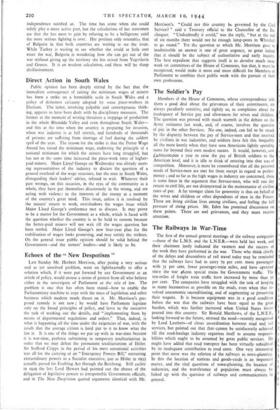The Railways in War-Time
The first of the annual general meetings of' the railway companies —those of the L.M.S. and the L.N.E.R.—were held last week, and their chairmen justly indicated the vastness and the success of the work they have performed in the war. Those who think chiefly of the delays and discomforts of rail travel today may be reminded that the railways have had to carry 70 per cent, more passengers with 31 per cent, fewer passenger-train miles, and have operated since the war 46,000 special trains for Government traffic. The ton-miles of freight train traffic have increased by more than 50 per cent. The companies have struggled with the task of keeping as many locomotives as possible on the roads, even when that in- volved uneconomic reconditioning, and of augmenting or preserving their wagons. It is because equipment was in a good condition before the war that the railways have been equal to the great burden, which was further increased when United States forces poured into this country. Sir Ronald Matthews, of the L.N.E.R., looking forward to the future, stressed the need—recently recognised by Lord Leathers—of closer co-ordination between road and rail services, but pointed out that that- cannot be satisfactorily achieved till the road-haulage industry organises itself to assume responsi- bilities which ought to be assumed by great public services. He might have added that road transport has been virtually subsidised by its inadequate contribution to road costs. One very interesting point that arose was the relation of the railways to town-planning. In this the location of stations and goods-yards is an important matter, and the vital questions of town-planning, the location of industries, and the transference of population must always be linked up with the question of railways and communications in
• general.


























 Previous page
Previous page